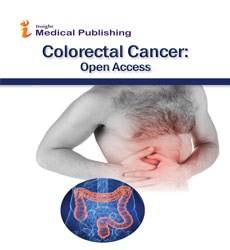The Metamorphosed Entrails
Department of Medical Science, University of Delhi, New Delhi, India
- Corresponding Author:
- Andrea
Department of Medical Science
University of Delhi, New Delhi, India
E-mail: andrea123@gmail.com
Received date: August 24, 2022, Manuscript No. IPJCC-22-14369; Editor assigned date: August 29, 2022, PreQC No. IPJCC-22-14369 (PQ); Reviewed date: September 13, 2022, QC No. IPJCC-22-14369; Revised date: December 23, 2022, Manuscript No. IPJCC-22-14369 (R); Published date: January 02, 2023, DOI: 10.36648/2471-9943.9.1.001
Citation: Andrea (2023) The Metamorphosed Entrails. Colorec Cancer Vol:9 No:1
Editorial
Colorectal Cancer (CCR) is the third most common cancer worldwide in men and women, the second largest cause of death related to cancer, and the main cause of death in gastrointestinal cancer. The risk of developing this cancer is related to bad alimentary habits, smoking, intestinal inflammatory disease, polyps, genetic factors, and aging. Of the patients that are diagnosed with colorectal cancer 90% are older than 50, with a median age of 64 years; however, the disease is more aggressive in patients that are diagnosed at younger ages. According to the American cancer association, it was accounted for more than 49,700 deaths in 2015. The goal is to reduce the mortality rate with early diagnosis and treatment. Currently, the survival rate is used to predict a patient’s prognosis. The patient is considered to have a positive familial history if a first degree relative has been diagnosed with colorectal cancer or colonic polyps before the age of 60, or also if two or more first degree relatives have been diagnosed with cancer or polyps at any age.
There are several methods for detecting colorectal cancer, such as the guaiac test, immunochemical test of stool, DNA stool test, sigmoidoscopy, colonoscopy, and barium enema. The stage in which the cancer is detected determines the prognosis, survival, and treatment of the patient. Provide a review about generalities, genetic basis, risk factors, protective factors, clinical course, diagnostic methods, therapy and survival in colorectal cancer. Conducted research from different databases such as PubMed, Medline, MedScape, on the definition, genetic factors, classification, risk factors, protective factors, diagnostic methods, epidemiology, survival and treatment of colorectal cancer. Articles from 2000 to 2017 were included using the following keywords.
The ingestion of non-steroidal anti-inflammatory drugs reduce the risk of colorectal cancer, however the molecular basis have demonstrated, which regulates the overexpression of the receptor of the Epidermal Growth Factor (EGFR), which is overexpressed in the 80% of the cases colorectal cancer, as an early event in colorectal tumorigenesis. The overexpression of the Cyclooxygenase 2 (COX-2) triggers the activation of the transcription factor of the c-Jun dependent Protein Activator 1 (AP-1) that binds to the promoter of EGFR; therefore selective COX-2 inhibitors can be used as quimiopreventive activity against colorectal cancer.
Colorectal surgery is performed for many diseases such as colorectal cancer, ulcerative colitis, Crohn’s disease, mechanical bowel obstruction and recurrent diverticulitis, often resulting in major reconstruction of the gastrointestinal tract. Injury, ischemia, rectal prolapse and proctological disorders may also require large or small bowel resection. Potential risks of colorectal surgery are mainly those of any major abdominal surgery, and usually occur while the patient is still in the hospital. Because of the many indications for and the various extents of colorectal or small bowel resections the rate and spectrum of complications differ.
Risk factors in emergency, in elective open and laparoscopic colorectal surgery should be recognized prior to surgery in order to reduce complications and to initialize individualized treatment as soon as possible. However, some risk factors such as age, gender and prior abdominal surgery can obviously not be influenced before surgery.
In general, complications can be divided into intraoperative and postoperative complications. Occurrence of intraoperative complications such as bleeding, bowel injury, ureteral lesions and bladder injuries are caused by intraabdominal adhesions, anatomic problems, the experience of the surgeon and many other factors. Major postoperative complications include wound infection, anastomotic leakage, ileus and bleeding. Only a few recent publications elucidate risk factors for intra and postoperative complications in colorectal surgery. The importance of some risk factors such as age, nutrition status of the patient and experience of the surgeon are becoming more accepted. In addition, there are many other factors that influence outcome of colorectal surgery which could be modified preoperatively.
Open Access Journals
- Aquaculture & Veterinary Science
- Chemistry & Chemical Sciences
- Clinical Sciences
- Engineering
- General Science
- Genetics & Molecular Biology
- Health Care & Nursing
- Immunology & Microbiology
- Materials Science
- Mathematics & Physics
- Medical Sciences
- Neurology & Psychiatry
- Oncology & Cancer Science
- Pharmaceutical Sciences
